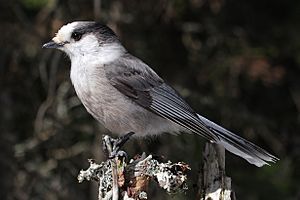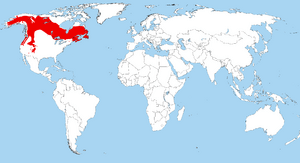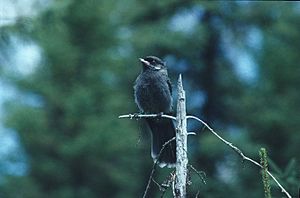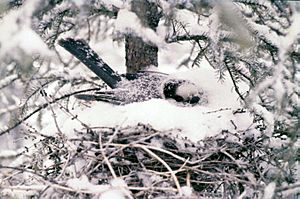Canada jay facts for kids
The Canada jay (Perisoreus canadensis), also known as the gray jay, camp robber, or whisky jack, is a type of passerine bird. It belongs to the Corvidae family, which includes crows and other jays. You can find this bird in the northern boreal forests of North America, reaching up to the tree line. It also lives in the Rocky Mountains subalpine zone as far south as New Mexico and Arizona.
Quick facts for kids Canada jay |
|
|---|---|
 |
|
| Conservation status | |
| Scientific classification | |
| Subspecies | |
|
9 subspecies; see text |
|
 |
|
| Canada jay range (note: map lacks distribution in New York state) | |
| Synonyms | |
|
The Canada jay is a fairly large songbird. It has pale grey feathers on its belly and darker grey feathers on its back. Its head is mostly grey-white with a darker grey patch on the back of its neck. It is one of three birds in the Perisoreus group. This group is actually more closely related to magpies than to other birds called jays. There are nine different types, or subspecies, of the Canada jay.
Canada jays live all year in their own special areas in coniferous forests. They survive the cold winter by eating food they have hidden away during warmer times. These birds form monogamous pairs, meaning they stay with one partner for life. Often, a young bird from the previous year also lives with the pair. Canada jays are very good at living near people. They are known to come close to humans to get food. This is why they have many nicknames like "camp robber" and "whisky jack." The International Union for the Conservation of Nature (IUCN) says the Canada jay is a least-concern species, meaning it is not currently at risk. However, populations in warmer southern areas might be affected by global warming.
This bird is important in the stories of several First Nations cultures. For example, it is linked to Wisakedjak, a kind trickster figure whose name was later changed to Whiskyjack. In 2016, a magazine called Canadian Geographic chose the Canada jay as Canada's national bird. This was decided through an online poll and a panel of experts. However, the Canadian government has not officially recognized it yet.
Contents
Meet the Canada Jay
The Canada jay is a type of songbird that is quite large. It is smaller than some other jays, though. A grown-up Canada jay is usually about 25 to 33 centimeters (10 to 13 inches) long. Its wingspan is around 45 centimeters (18 inches). It weighs about 65 to 70 grams (2.3 to 2.5 ounces).
What They Look Like
Adult Canada jays have medium grey feathers on their backs. Their undersides are a lighter grey. Their heads are mostly white with a dark grey or black patch on the back of their necks, like a hood. They have a short black beak and dark eyes. Their long tails are medium grey with lighter tips. Their legs and feet are black.
Their feathers are very thick. This helps keep them warm in their cold homes. Male and female Canada jays look very similar, but males are usually a little bigger. Young Canada jays are born a very dark grey color all over. They get their adult feathers after their first molt in July or August. Canada jays that have their own territory usually live for about eight years. The oldest known Canada jay lived to be at least 17 years old!
How They Communicate
Canada jays make many different sounds. Like other birds in their family, they can even copy the sounds of other birds, especially predators. Their calls include a whistling quee-oo and various clicks and chuckles. If they see a predator on the ground, they make harsh clicks to warn others. If they see a predator in the air, they make a series of repeated whistles.
Where Canada Jays Live
The Canada jay lives across northern North America. You can find them from northern Alaska all the way east to Newfoundland and Labrador. They also live south into northern California, Idaho, Utah, Arizona, New Mexico, Colorado, and South Dakota. They are also found in the northern parts of Minnesota, Wisconsin, Michigan, New York, and New England.
Their Favorite Homes
Most Canada jays live where there are lots of black spruce (Picea mariana), white spruce (P. glauca), Engelmann spruce (P. engelmanni), jack pine (Pinus banksiana), or lodgepole pine (P. contorta) trees. They don't live in places like the Sierra Nevada mountains in California if there are no spruce trees. They also avoid coastal areas of Alaska or British Columbia that are mostly Sitka spruce (Picea sitchensis).
The main things they need in their habitat are cold enough temperatures to keep their stored food fresh. They also need tree bark with flexible scales. This type of bark allows them to easily tuck food items into dry, hidden spots for storage. The bark and leaves of these northern trees might even have properties that help keep food from spoiling.
Canada Jay Behavior
Family Life
Canada jays usually start breeding when they are two years old. They are monogamous, meaning they stay with the same partner for their whole lives. If one partner dies, the other will find a new mate. They breed in March and April, depending on how far north they live. They don't try to have a second group of babies in the same year. This might give them more time to store food.
Canada jays often have a helper bird during breeding season. This helper is usually a young bird from the parents' previous year. This helper bird does not feed the new babies right away. The parents will chase it away from the nest until the young birds have left the nest. This might help keep predators away from the most vulnerable young. Once the young birds can fly, the helper bird will start to bring food to its younger siblings. This "cooperative breeding" can help the parents, make sure the babies get enough food, and help spot predators. The dominant young bird might even take over the family territory later on.
Building Nests and Laying Eggs
Canada jays build their nests and lay eggs in March or even February. This is when the snow is still very deep in the boreal forest. The male Canada jay chooses a good spot in a mature conifer tree. They often choose black spruce trees, but also use white spruce and balsam fir. The male takes the lead in building the nest. They use dry twigs, strips of bark, and lichens.
The nest is shaped like a cup and is just big enough for the female and her eggs. It's about 8 centimeters (3 inches) wide and 5 centimeters (2 inches) deep. To keep it warm, they fill gaps in the nest with cocoons from the forest tent caterpillar. They also line the inside with feathers. Nests are usually built on the southwest side of a tree to catch the sun's warmth. They are typically 2.4 to 9 meters (8 to 30 feet) above the ground.
A female Canada jay lays 2 to 5 light green-grey eggs with darker spots. The female is the only one who sits on the eggs to keep them warm. This takes about 18.5 days. Her partner feeds her while she is on the nest. She rarely leaves the nest during this time and for a few days after the eggs hatch.
Raising the Young
Canada jay babies are born helpless and need a lot of care. For the first three to four days after hatching, the female stays on the nest. When the male brings food, both parents feed the nestlings. The babies grow fastest from day four to day ten. During this time, the female starts to help find food. The parents carry food to the nest in their throats. The helper bird does not feed the babies during this time.
Young Canada jays leave the nest when they are between 22 and 24 days old. After they leave the nest, the helper bird starts to help find and bring food. After about 55 to 65 days, the young jays are fully grown. They will then fight among themselves until one strong young bird makes its siblings leave the family area. This strong bird stays with its parents until the next breeding season. The other young birds leave to find another pair of adults who didn't have babies, or they might try to find a new place to live.
How They Find Food
Canada jays are omnivores, meaning they eat both plants and animals. They hunt small creatures like insects and small mammals, including rodents. They also eat baby birds from nests. They have even been seen catching a magnolia warbler in the air! They sometimes eat young amphibians like frogs and salamanders. Canada jays have also been seen landing on moose to pick off and eat ticks.
They often eat baby birds from nests in trees. They find them by moving from branch to branch and looking around. Canada jays also eat carrion (dead animals), fungi, fruits like chokecherry, and seeds. They have even been seen eating slime mold. Canada jays choose food that gives them the most energy. They will twist and pull food apart, unlike some other jays that grasp and hammer their food. They often carry large food items to nearby trees to eat or hide them. This might be to protect their food from bigger scavengers.
Hiding Food for Later
The Canada jay is a "scatterhoarder." This means it hides thousands of food items during the summer. They use this stored food to survive the winter. This amazing ability allows them to stay in cold northern forests all year round. Any food they plan to store is shaped in their mouth into a ball. This ball is covered with sticky saliva, which makes it stick to anything it touches. They hide these food balls in cracks in bark, under clumps of lichen, or among conifer needles. They can hide anything from dead animals to bread crumbs.
A single Canada jay can hide thousands of pieces of food each year. They remember where they hid them, sometimes months later! This hidden food is often used to feed their babies and young birds. When they find food far away, Canada jays might first hide it all in one spot at the edge of a forest. This helps them hide a lot of food quickly and reduces their risk of being caught by predators. Later, they move the food to many different, scattered spots to prevent other animals from stealing it.
Other birds, like Steller's jays, and even Canada jays from nearby territories, will try to steal their hidden food. To stop this, Canada jays will carry larger food items further away to hide them. They also carry valuable food items further away if other Canada jays are watching. Hiding food in many different places makes it harder for others to steal. In warmer parts of their range, Canada jays don't hide food in the summer. This is because the food would spoil, and they don't need as much stored food for winter.
Who Hunts Canada Jays?
Several birds hunt Canada jays. These include great grey owls, northern hawk-owls, and Mexican spotted owls. Canada jay remains have also been found in the dens of animals like fishers and American martens. Red squirrels are known to eat Canada jay eggs. Canada jays warn each other about dangers by whistling, screaming, chattering, or by copying and chasing predators.
Canada Jays and Humans
Cultural Importance
The Canada jay is found all across Canada and has many popular nicknames. One is "whisky jack," which comes from the name of Wisakedjak. Wisakedjak is a kind trickster hero in the Cree, Algonquin, and Menominee stories. Other spellings for this name include wesakechak and wisakadjak. The Tlingit people in northwestern North America call it kooyéix or taatl'eeshdéi, which means "camp robber."
According to the Mi'kmaq people of Nova Scotia, each of the seven stars in the Big Dipper represents a different bird. The star Eta Ursae Majoris in the night sky was the Canada jay, called Mikjaqoqwej. In the Ojibwe language, anishinaabemowin, the bird is known as gwiingwiishi. Many Indigenous peoples respect the whisky jack. They see it as a sign of good luck or a warning of danger. Niigaanwewidam Sinclair, a professor at the University of Manitoba, explained why the Canada jay is important to the Anishinaabe people. He said, "To my people, the Anishinaabe, she is Gwiingwiishi. Gwiingwiishi is a great, wise teacher, and there is an old story that tells of her abilities to give gifts... Her lesson? That it is only in our bravery, resilience and commitments to one another that we can find growth."
Canada jays are very good at finding new food sources, including food left by humans. They are known to be bold and will approach people for treats or steal from unattended food. This can be frustrating for trappers or early travelers trying to protect their food. But it can be delightful for campers! Canada jays don't change their feeding behavior if people are watching them. If they learn that humans mean food, they won't forget. This behavior has given the Canada jay many nicknames like "lumberjack," "meat-bird," "venison-hawk," "moose-bird," and "gorby."
In January 2015, Canadian Geographic magazine started a project to choose a national bird for Canada. Canada had never officially chosen one before. They held an online poll for Canadians to vote for their favorite bird. In November 2016, the Canada jay was chosen as the winner! The organizers hoped the Canadian government would officially recognize it. However, the government said they were not considering new official symbols at that time.
Protecting the Canada Jay
The Canada jay is listed as a least concern species by the IUCN Red List. This means its populations are stable over a very large area. These areas are mostly northern forests and mountains, where there are not many people. However, climate warming caused by humans might affect them. Canada jays in the far north might benefit if spruce forests spread into areas that used to be treeless. But a study of a declining population in the southern part of their range found a link between warmer autumns and fewer successful nests. These warmer temperatures might cause the perishable food that Canada jays store to spoil. This stored food is very important for their nesting success in late winter.
See also
 In Spanish: Arrendajo canadiense para niños
In Spanish: Arrendajo canadiense para niños







